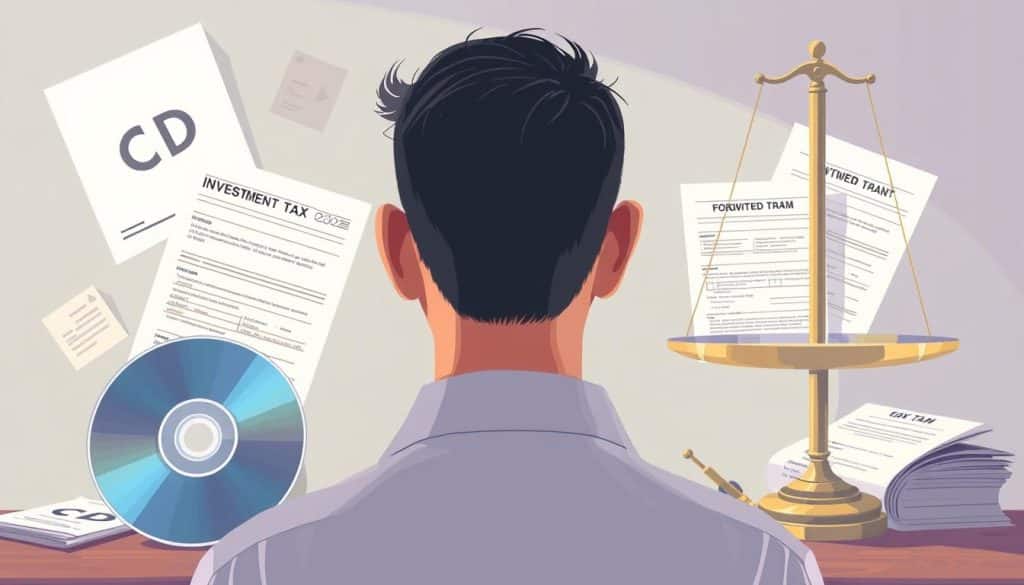No investor has ever lost money in CDs backed by the FDIC, even if a bank fails1. This fact shows how safe Certificates of Deposit (CDs) are. With the economy always changing, CDs can be a great choice for those wanting safe and sure returns. Recently, the highest CD yields are at their peak in more than ten years2, offering a chance for investors to get great rates.
Thinking about adding CDs to your portfolio? Consider their pros and cons first. CDs promise to return your initial investment and are protected by the FDIC up to $250,000 per person, per bank, for each account type1. The five-year CD average rate is 1.44 percent APY, but the best rates are much higher1. Yet, these rates can change with the economy. As the Federal Reserve changes its policies, CD yields may go up or down, offering both chances and risks for investors2.
Key Takeaways
- Certificates of Deposit (CDs) provide a secured return with FDIC protection, making them a safe investment choice1.
- The average five-year CD currently offers a 1.44 percent APY, but top rates can be significantly higher1.
- CD yields are the highest they have been in over a decade, offering an excellent opportunity for investing in CDs2.
- Anticipated Federal Reserve rate cuts could affect future CD rates, making it crucial to monitor market trends2.
- FDIC-insured investments like CDs remain a solid choice during economic uncertainties, guaranteeing the safety of your principal1.
Understanding Certificates of Deposit (CDs)
Courses of Deposit (CDs) let you put away cash for a certain time. You earn a steady interest. They’re safe up to $250,000 per person thanks to FDIC or NCUA3.
Definition and Basics
A CD keeps your money for a set term. Banks give you a higher interest rate for it. It’s often much more than what regular savings accounts offer3.
Currently, rates can top 5%. The best rates today are the highest in ten years4.
Types of CDs
There are many CDs to choose from, based on your financial goals:
- Fixed-Rate CDs: They have the same interest rate the whole term.
- Bump-Up CDs: You can up the rate once during the term.
- Step-Up CDs: Rates go up at set times.
- Jumbo CDs: These need big deposits, usually $50,000 or more, but have bigger interest rates3.
- Variable-Rate CDs: Their rates can change with the market.
Marcus by Goldman Sachs High-Yield CD and Alliant Credit Union Certificate offer about 4.60% for one year4. Betterment Cash Reserve has up to 5.50%, showing the range of options4.
How They Differ from Savings Accounts and Bonds
CDs and savings accounts differ in two main ways: how easy you can get your money and interest rates. CDs usually have higher rates but you can’t touch your money for a while. Savings accounts let you withdraw anytime, but the rates are lower3.
Bonds might give you more money back, but they’re riskier. They also don’t have the FDIC insurance CDs do. With rising rates due to the Federal Reserve, CDs are looking good34.
Advantages of Investing in CDs
Certificates of Deposit (CDs) are a great way to invest your money. They offer guaranteed returns, are safe because they’re insured by the FDIC, and the interest rates don’t change. These features make planning for the future easier.
Guaranteed Returns
The main benefit of CDs is the sure returns they provide. Unlike the stock market or real estate, CDs have less risk because their returns are fixed. This means you’ll know exactly how much money you’ll make5. During uncertain economic times, the stable interest from CDs is very comforting6.
Safety and FDIC Insurance
CDs are among the safest investment options. The FDIC insures them up to $250,000 per depositor, at each bank5. So, if the bank fails, your money is still safe. This insurance is perfect for investors who don’t like risks and want peace of mind7.
Predictable and Fixed Interest Rates
Another key advantage of CDs is they have fixed and predictable interest rates. Your rate won’t change for the whole term6. This means you can secure a good rate even if market rates go up or down. It’s a smart choice for adding stability to your investments7.
If you’re cautious with your investments or want a surefire way to grow your money, CDs are a solid choice. They offer safety, consistent returns, and the ease of knowing your investment isn’t going to fluctuate. With these benefits, CDs can be a strong part of a diverse investment plan.
Risks and Drawbacks of CDs
Certificates of Deposit (CDs) offer a safe investment choice. Yet, it’s crucial to know the risks and drawbacks of CDs first. This helps decide if they are right for you.
Early Withdrawal Penalties
The major drawback of CDs is the early withdrawal penalty. Taking out your money before the CD’s term ends means facing penalties. These penalties often eat up the interest you’ve earned. Some banks might let you withdraw early without a fee. Yet, these CDs usually have lower interest rates8.
Inflation Risk
Inflation affecting CDs is another worry. CDs offer annual percentage yields from 2.00% to 4.50%9. But if inflation is high, it can lessen what your investment is worth over time9. This means you might not make as much in the long run.
Opportunity Cost of Higher Returns
Lastly, there’s the opportunity cost to think about. Your money is tied up in a CD for a certain time, from 3 months to 10 years9. During this time, you could miss out on making more money in other investments like stocks or mutual funds. These often have higher returns than what you’d get from a CD9. Choosing a CD with a long term might offer better interest rates. However, it also means less flexibility and missed chances for earning more elsewhere.
High Yield CDs: Maximizing Your Return
High yield CDs show a great chance for upping your CD earnings. They give much better interest rates than usual CDs. This makes them key for boosting your investment results.
Finding Competitive Rates
Looking for the best rates? Try online banks and credit unions. They often have better terms than regular banks. Right now, the top CDs give more than 5% APY for terms between 18 months to 3 years10.
It’s vital to keep an eye on various offers to get the best deal.
Current Market Trends
It’s important to understand the trends in the CD market. For example, the best 3-year CD rates are about 4.3% right now. Meanwhile, traditional banks’ money market rates usually are under 1%11. Knowing these trends helps you make smart moves before rates change.
Pros and Cons of High Yield CDs
High yield CDs have big pluses, like higher interest rates that boost your returns. But, there are drawbacks. For example, you’ll face higher penalties if you withdraw early. Also, there’s a risk that rates will be lower when your CD is up for renewal. Still, the chance to earn more often beats these risks.
| Investment Type | Average Annual Return |
|---|---|
| High Yield CDs | Up to 5% APY10 |
| Money Market Accounts | Less than 1%11 |
| Peer-to-Peer Lending | 5.7%11 |
CD Ladder Strategy Explained
The CD ladder strategy is about opening different CDs that end at various times. This plan helps you balance getting your cash when needed and earning the most interest. It’s great for those who want good rates but also need some cash available regularly.
How to Build a CD Ladder
To make a CD ladder, you put money into CDs that end at different times, like 3 months, 6 months, 1 year, and 5 years12. Begin by splitting your investment across various CDs. Say you have $5,000. You could put $1,000 into five different CDs. When one CD ends, you can put that money into a new, longer-term CD. This way, your money keeps working for you13.
This method lets you use some of your funds soon and grow the rest over time.
Benefits of Laddering CDs
CD laddering has many perks. One big plus is getting to use about 25% of your cash each year because one CD will end13. This plan lessens the risk of not having cash when you need it. It often earns more than savings accounts do. The longer a CD lasts, the more interest you usually get, boosting your total earnings12. Also, it’s nice to know exactly how much money you’ll get back, making it a solid choice for careful investors13.
Examples and Scenarios
Think about making a five-year CD ladder with $2,500 spread out over five CDs ending at different times—3 months, 6 months, 1 year, 3 years, and 5 years. This way, you can keep investing in new CDs to possibly get higher annual interest rates13. On the other hand, a small CD ladder could use shorter periods like 3-month, 6-month, 9-month, and 1-year CDs12. You can adjust these plans to fit your needs, whether you want more cash on hand, stable returns, or to lock in better rates.
When CDs Are a Good Investment
Certificates of Deposit, or CDs, are great if you’re looking for a safe way to save money short-term. They have fixed interest rates, so you know exactly how much you’ll get back. This makes them a smart pick if you don’t like risks but want to earn on your savings.
Short-Term Financial Goals
Got a big purchase coming up, like a house or needing money for school? CDs might be a good fit. You can pick how long your money stays in one, from just a few weeks to several years. This lets you time it right to meet your goals14. They often give better interest than regular savings accounts, so your money grows more15.
Low-Risk Investment Strategies
For safe and steady money growth, CDs are key. Sometimes banks offer rates over 5%, which is pretty good without the risks of stocks14. The CD ladder strategy is smart too. It means putting money in several CDs at once, each ending at different times. This keeps your money accessible15.
Considerations for Risk-Averse Investors
If you’re careful with your investments, CDs are worth a look. They’re safe, have guaranteed returns, and are backed by insurance. So, you don’t have to worry about losing your money14. Just remember, taking your money out early can cost you a bit in fees. It’s something to think about when you choose CDs14.
How to Invest in CDs
Investing in Certificates of Deposit (CDs) needs careful planning for the best returns. It is key to know the basics and the steps before you choose where and how to invest in CDs.
Choosing the Right Bank or Credit Union
Pick banks or credit unions with good reputations, competitive rates, and low fees for your CDs. The FDIC ensures your deposit up to $250,000 if the bank fails16. For example, Discover® has a 12-Month CD offering a 4.50% Annual Percentage Yield (APY) with a minimum $2,500 deposit16. Also, explore different CD types like no-penalty or add-on CDs for more flexibility or better rates for certain terms17.
Steps to Open a CD Account
To open a CD account:
- Look at interest rates and terms from different financial institutions.
- Pick a CD type and deposit amount that fits your investment plan.
- Fill out the application, which can usually be done online.
- Add money to the CD by transferring it from your bank account.
This process makes sure your CD account matches your financial goals and preferences.
Factors to Consider Before Investing
Think about these things before investing in CDs:
- Interest rates: CDs often offer a set interest rate for a time, giving you better returns than most savings accounts16. The average APY for a 1-year CD is now 4.60%18.
- Early withdrawal penalties: Know the penalties for taking money out early, as they can differ a lot17.
- Investment strategies: Use CD laddering for access to funds over time or CD barbells or bullets as needed18.
- Institution’s reliability: Check that the bank or credit union is FDIC-insured to protect your money up to $250,00016.
Considering these points helps you decide wisely and line up your CD investments with your financial plans.
Comparing CD Rates
Comparing CD rates is easier with online tools and calculators. They quickly show how much you could earn from your investments. This helps you pick the best option based on the latest market trends.
Using Online Tools and Calculators
Online CD calculators simplify comparing rates. They show how much interest you might earn on different CDs. By looking at the term length and how much you invest, you find which CDs might give you the most money back19.
Top Banks Offering Competitive Rates
Right now, several banks offer great CD rates. For example, CIBC Bank USA has a one-year CD at 5.36% APY. BMO Alto has a similar deal at 5.05% APY with no need to put down a specific starting amount20.
Discover® offers a 10-year CD at 3.75% APY. But remember, long-term CDs are less flexible and might be riskier than other investments like the stock market20.
Impact of Federal Reserve Policies on CD Rates
The Federal Reserve’s decisions affect CD rates. When the federal funds rate changes, it impacts bank interest rates on CDs21. For instance, when rates go up, CD rates usually do too, making them more appealing for those looking for safe, fixed-income options21.
Knowing how the Federal Reserve influences rates, using online tools, and keeping up with bank offers can help you make the most of your CD investments21.
Are CDs a Good Investment in 2024?
To understand if CDs are a good choice in 2024, we need to look at market predictions, how the economy affects CD rates, and what experts say. This will help you make a smart choice.
Market Predictions and Trends
Currently, the best CD rates are over 5%, a big jump since June 202222. From June 2022 to December 2023, one-year CD rates soared by more than 700%22. This growth shows that investors are very interested in short-term options that offer solid returns. In 2024, the national average for CD interest rates is the highest it’s been in over ten years23. This tells us that CDs are still attractive for those who prefer to play it safe.
The Federal Reserve has hiked interest rates 11 times in the past 15 months, making a big impact on CD rates23. Right now, short-term CDs have higher rates than long-term ones, showing an inverted yield curve23. This makes short-term CDs appealing for those wanting high returns without much risk.
Economic Factors Influencing CD Rates
Inflation plays a big role in shaping CD rates. For example, in December 2023, inflation was 3.40%, leaving a real return of just 0.40% for a 5% CD before taxes22. By March 2024, inflation is around 3.2%, making credit union CD rates close to or the same as inflation23. These figures are important when choosing CDs as your investment.
Your decision to invest in CDs in 2024 should account for current inflation rates, recent Federal Reserve policies, and the ever-evolving market trends.
Expert Opinions and Forecasts
Experts believe CD rates may begin to fall in 2024, but banks may try to keep rates high, suggesting a decrease by year’s end23. This outlook offers a chance to secure good rates before they go down. Yet, strategies like CD laddering might not work as well in 2024 with high rates expected to drop23.
CDs are still a great pick for those who want a safe and low-risk way to invest. By looking at CD market trends and how the economy affects rates, you can choose wisely for your financial future in 2024.
| CD Term | Interest Rate |
|---|---|
| 1-Year CDs | Up to 5.92% APY |
| 3-Year CDs | Up to 5.92% APY |
| 5-Year CDs | Up to 4.80% APY |
Alternative Investments to CDs
Looking for different ways to invest beyond CDs? Consider options that mix safety with potential growth. TIPS, money market accounts, and stocks, mutual funds, and ETFs are good choices.
Treasury Inflation-Protected Securities (TIPS)
TIPS are bonds from the government. They keep your buying power stable by adjusting for inflation. They come in 5, 10, and 30-year terms, offering a real safeguard for your money24.
For those seeking low risk, Treasury bonds are appealing. They can provide more than 5% returns, making them a strong alternative to CDs25.
Money Market Accounts
Money market accounts combine a checking account’s access with the higher interest of a savings account. They often offer better rates, going up to 5.25%. This makes them a tempting option instead of CDs26.
These accounts are also safe, thanks to FDIC insurance. This guarantees the protection of your investment.
Stocks, Mutual Funds, and ETFs
Ready for more risk? Stocks, mutual funds, and ETFs could bring significant rewards. For example, the S&P 500 has seen a return of about 1.8%, despite its ups and downs25.
Between 1926 and 2019, mixed stock and bond investments averaged annual returns of 8.33%. This proves they can outperform bonds and CDs26.
| Investment Type | Return Rate | Risk Level |
|---|---|---|
| High-Yield CDs | Up to 6.50% | Low |
| Money Market Accounts | Up to 5.25% | Low |
| TIPS | Inflation-Adjusted | Low |
| Stocks | Varies significantly | High |
Each of these alternatives to CDs has its own pros and cons. TIPS and money market accounts are safer and offer steady returns. On the other hand, stocks and mutual funds can bring higher earnings, but with more risk. Choose investments that match your financial goals and how much risk you can handle.
Pros and Cons of CD Investing
Certificates of Deposit (CDs) are a good pick for cautious investors who want a safe place for their money. One big perk of CDs is they have fixed interest rates. This means you know exactly what you’re getting back. They’re less risky than stocks or mutual funds. Also, CDs are insured up to $250,000 by the FDIC. This adds a layer of safety for your investment27.
Advantages for Conservative Investors
For those looking at the pros and cons of CD investing, the upsides for cautious investors are clear. CDs often have better interest rates than regular savings accounts. For example, the average interest on savings is 0.46%, while a one-year CD is around 1.81%28. That’s almost four times more. This makes CDs an appealing option for those who want a better return without risk. Plus, CDs come in various term lengths. This lets you pick one that fits your future plans27.
Downsides and Challenges
Even with their upsides, CDs have downsides to consider. A big one is the penalty for taking your money out early. If you need to access your cash before the CD’s term ends, you’ll face a penalty. This penalty is often a few months’ worth of interest28. Also, inflation could rise faster than your CD’s interest rate. This can lower the value of your returns29. Lastly, you might miss out on earning more elsewhere, as CDs usually earn less than the stock market27.
Comparing CD Investments with Other Options
Comparing CDs with other investment choices, CDs are safer but might offer lower returns. For example, TIPS and money market accounts are more liquid but typically have lower interest rates. On the other side, stocks and mutual funds could provide bigger returns but come with more risk. It’s crucial to balance the pros and cons of CD investing with your financial goals and risk tolerance. Think about your time frame, need for cash, and market conditions when choosing CDs for your portfolio29.
For those seeking conservative investments with potentially higher returns, credit unions and community banks have options. Products like the Save To Win® Certificate from Credit Union of America offer flexibility for investors. They allow smaller deposits and the chance to win prizes29.
To learn more about investment services nearby, visit investment services near me.
Tax Implications of CD Investments
Investing in certificates of deposit, or CDs, can lead to important tax effects. It’s key to understand the tax on CD interest and its impact on your financial plans. The IRS sees interest from CDs as taxable income. This is true no matter if you get the money or put it back into your account30. So, if your CD interest is over $10, you must tell the IRS30.
Understanding Interest Income Tax
For CDs that last a year or less, taxes are due on the interest as it’s earned and paid31. With CDs that go beyond a year, you report and pay taxes annually, even if you can’t access the CD yet30. Also, the tax on CD interest depends on your tax bracket and how much you gain, affecting the total tax30.
Strategies to Minimize Tax Burden
Looking into ways to lower the tax from CD interest is wise. One way is to balance the taxes due on interest with penalties from early withdrawal31. Also, using a retirement account like an IRA or a 401(k) for your CDs can put off the taxes until you retire or take the money out31. Next year, you can put up to $7,000 in an IRA, or $8,000 if you’re 50 or older31.
Reporting and Compliance
Following IRS rules for CD interest income is essential. You must report interest over $1030. You can lower your tax by deducting early withdrawal penalties30. Proper reporting and using tax-reducing strategies are key for handling CD tax effects well.
How to Use a CD Investment Calculator
A CD investment calculator can make your money planning much clearer. It shows how your investment will grow over time. This is done by looking at the growth of your CD.
Benefits of Using an Investment Calculator
A key advantage of a CD investment calculator is seeing your interest ahead of time. It makes it easier to choose wisely. As of September 202432, the average CD rate is 1.88%, says the FDIC. Pop that rate into your calculator to see potential growth. It also lets you compare different financial products to find the best one.
Step-by-Step Guide
Follow these steps to get the most from your CD investment calculator:
- Start by entering how much you’re putting in. Say, $5,000.
- Choose how long you’ll keep your CD. It could be months or years.
- Put in the interest rate. With a 2.50% rate for a year, you’ll get $125 in interest32.
- Pick how often interest gets added to your CD. This can change your total earnings.
- Look at what you might get back and compare it with other options.
Interpreting the Results
Understanding a CD investment calculator‘s output is easy. It tells you your interest and the final amount. For instance, a 5-year CD at a good online bank might offer 4.00% APY. This could net you about $108 in interest over five years. A CD at 1% would only give you around $2633. This info helps you pick CDs that meet your goals. By doing so, you ensure your money is really working for you.
The following table compares different CDs. It shows how different rates and periods affect your return.
| CD Term | Interest Rate (APY) | Initial Deposit | Interest Earned | Total Amount |
|---|---|---|---|---|
| 12-Month | 2.50% | $5,000 | $125 | $5,125 |
| 5-Year | 4.00% | $3,000 | $108 | $3,108 |
| 1-Year | 5.00% | $10,000 | $500 | $10,500 |
Best CDs to Invest in Right Now
Looking for the best CDs to invest in? The right bank or credit union can make a big difference. America First Credit Union, Barclays Bank, and Quontic Bank stand out with their competitive rates. For example, Merchants Bank of Indiana has a 5.25% APY on CDs for 3 to 12 months, needing a $1,000 minimum deposit34.
Mountain America Credit Union also offers a 5.25% APY for CDs lasting 6 and 12 months. You only need to deposit $500 to start34. These great deals make them worth considering right now.
Top Banks and Credit Unions Offering CDs
Knowing the best banks for CD investments is key. Communitywide Federal Credit Union gives you a 5.25% APY for a 6-month CD with a $1,000 deposit34. Vibrant Credit Union offers 5.25% APY for 6 months and 5.15% for 13 months, with only a $5 minimum deposit needed34. And lately, CD rates have been climbing, following the Federal Reserve’s lead35.
Find the top options for your investment by checking out this list here.
Comparison of Terms and Rates
It’s vital to compare CD terms to meet your financial goals. My Banking Direct and AloStar offer a 5.25% APY for 5-month CDs. Yet, they require different minimum deposits of $2,500 and $10,000, respectively34. This shows how terms can vary widely.
Right now, the average one-year CD rates exceed 4.84% APY, with some reaching 5%35. Look out for special rates on unique terms for better deals35.
Special Promotions and Offers
Banks sometimes offer no-penalty CDs with about 4.00% APY for 11 months35. These let you withdraw early without losing money, offering flexibility. Climate First Bank has an appealing deal now with a 5.24% APY on a 6-month CD. No early withdrawal penalties here, and you only need $500 to start34.
Keeping up with these promotions ensures you grab the most beneficial yields and terms.









